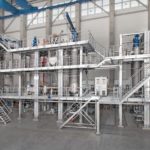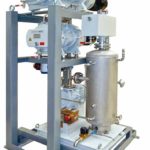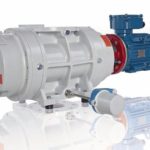Many organic substances have a boiling point higher than 200 °C or are temperature-sensitive, and in this case vacuum distillation is the preferred separation method. Especially with temperature-sensitive products, the dwell time in the vaporisation device is an important aspect.
In many cases, batch distillation in a reactor is unsuitable due to the dwell time, which can extend to hours, and because not enough vacuum results from the fluid column in the vessel. A fill level of 10 cm, for instance, means a density-dependent pres-sure of about 10 hPa. For this reason, thin-film vaporisers and short-path evaporators are used in industrial applications. In these cylindrical systems, a very thin film (thickness 1 to 3 mm) of the liquid to be vapor-ised is applied to the inside surface of the heated cylinder using rollers or wiper blades. Depending on the size of the system, the dwell time may be only a few seconds. Thin-film vaporisation works best within a pressure range from 1 to 100 hPa. Lower pressures are difficult to achieve due to pressure losses in the vaporous substances flowing from the device to the condenser.
However, pressures in the region of 0.01 hPa are required for the separation of mono-, di- and triglycerides, for example. In this case, the so-called short-path distillation method is chosen. The condenser is located at the centre of the cylindrical vaporiser and the distances between the hot wall and the water-cooled pipe coil are in the order of a few centimetres, depending on the size of the device. Pressure losses are minimised because the material to be evaporated condenses directly on the cold surface. Since the mean free path of a molecule in a medium vacuum is similar to, or significantly greater than, the distance between the cylinder and the internal condenser, this method is also referred to as molecular distillation.
If the vapour pressures of the substances to be separated are very close together, vacuum rectification columns are used. In these counter-current distillation systems, the vapour flows through a vertically aligned column to the condensed liquid. Installations such as structured packings ensure good mixing of the two phases, so that a phase equilibrium can be achieved. The dwell times and pressure levels are higher than with thin-film vaporisers, however. The two processes are often combined.
Roots pumping stations
Maintaining the exact vacuum pressure required in the vaporiser is vitally important for the quality of the separation process and imposes considerable demands on the vacuum control system and the vacuum pumps used.
Pfeiffer Vacuum therefore offers a large selection of suitable vacuum equipment for thin-film and short-path distillation. In practice, Roots pumping stations with liquid ring pumps have proven to be the ideal solution. Depending on the number of Roots piston stages, a pressure of 10–3 hPa can be achieved without much effort. It is also possible to operate the liquid ring pump with the substance that needs to be distilled. One example involves processing rolling oil. The oil contaminated by the rolling operation is reprocessed by distillation. For this, three-stage Roots pumping stations consisting of two Roots pumps and a liquid ring pump are used. The rolling oil to be distilled serves as the operating liquid for the liquid ring pump. At a pressure of approximately 5 hPa, the rolling oil evaporates and is condensed in the downstream condenser. The possibility of leakage air saturated with oil vapours being sucked into the vacuum pump system, where these vapours are then condensed again in the liquid ring pump, cannot be completely ruled out, however. Yet if the rolling oil is used as the operating liquid, this will have no negative effects on the pump’s throughput. The level of the liquid in the circulatory container of the liquid ring pump rises slowly. When the maximum permitted level is reached, the operating liquid is automatically discharged and fed to a suitable treatment process. Depending on the application, dry backing pumps can also be employed instead of the liquid ring pump.
Complete range
Based on its comprehensive range of products, Pfeiffer Vacuum offers customised so-lutions to create the vacuum conditions required for a variety of applications. Especially where applications in the chemical industry are concerned that require a pres-sure of less than 33 hPa, the Roots pumping stations in Pfeiffer Vacuum’s Oktaline series have established themselves as ideal solu-tions. Depending on the required pumping speed and ultimate pressure, different pumping stages can be built in. Roots pumps with a pumping capacity of 145 m3/h to 8000 m3/h are available as standard. In special cases, Roots pumps with a pumping speed of up to 25,000 m3/h can be manufactured.
The gas circulation-cooled version of the Oktaline allows compression to ambient pressure and is used predominantly in critical processes in the chemical industry. The standard pumps are made of spheroidal graphite cast iron (GGG40), which ensures the high pressure shock resistance (16 bar) of the pump housing. This is particularly important for Atex applications. For highly corrosive applications, the Oktaline can be made of stainless steel. It is also possible to apply a plasma-polymer coating to the parts of the suction chamber that come into contact with the product. More demanding pump tightness requirements are met with the aid of magnetically coupled drives with leakage rates of less than 1 · 10–6 Pa m3/s.
Online search: cpp0319pfeiffervacuum
Authors: Dr. Stefan Zabeschek Ingo Heitz Meike Strasheim
Application- & Project Manager Industry market
segment,
Pfeiffer Vacuum
Industry market segment,
Pfeiffer Vacuum
Industry market segment,
Pfeiffer Vacuum









